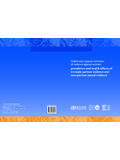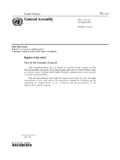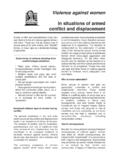Transcription of Violence against women Definition and scope of the problem
1 Violence against womenDefinition and scopeof the problemViolence against women and girls is a majorhealth and human rights issue. At least one infive of the world s female population has beenphysically or sexually abused by a man or menat some time in their life. Many, includingpregnant women and young girls, are subjectto severe, sustained or repeated , it has been estimated thatviolence against women is as serious a causeof death and incapacity among women ofreproductive age as cancer, and a greatercause of ill-health than traffic accidents andmalaria abuse of women is effectively condonedin almost every society of the and conviction of men who beator rape women or girls is rare when comparedto numbers of assaults. Violence thereforeoperates as a means to maintain and reinforcewomen s Nations definitionThe Declaration on the Elimination of ViolenceAgainst women , adopted by the UnitedNations General Assembly in 1993, definesviolence against women as any act of gender-based Violence that results in, or is likely toresult in, physical, sexual, or psychologicalharm or suffering to women , including threatsof such acts, coercion or arbitrary deprivationof liberty, whether occurring in public or privatelife.
2 2 It encompasses, but is not limited to, physical, sexual and psychological violenceoccurring in the family, including battering,sexual abuse of female children in thehousehold, dowry related Violence , maritalrape, female genital mutilation and othertraditional practices harmful to women , non-spousal Violence and Violence related toexploitation; physical, sexual and psychologi-cal Violence occurring within the generalcommunity, including rape, sexual abuse,sexual harassment and intimidation at work, ineducational institutions and elsewhere; traf-ficking in women and forced prostitution; andphysical, sexual and psychological violenceperpetrated or condoned by the state,wherever it occurs. Why are definitions and measurementsimportant?Accurate and comparable data on violenceare needed at the community, national andinternational levels to strengthen advocacyefforts, help policy makers understand theproblem and guide the design of the true prevalence of Violence ,however, is a complex task.
3 Statisticsavailable through the police, women s cen-tres, and other formal institutions oftenunderestimate levels of Violence because research is more accurate,but the lack of consistent methods anddefinitions makes comparisons across studiesdifficult. Because definitions are subjective,survey questions often ask whether womenexperience specific acts of Violence , during afixed period of time. While some studiesexamine only physical abuse, others mayconsider physical, sexual and psychologicalabuse. In family Violence research, some mayinclude only those women currently in arelationship, while others report on womenwho have ever been severity of Violence recorded may alsovary between studies. For example, oneresearcher may record all Violence regardlessof whether it results in bodily injury, whereasanother researcher may record only incidentsin which a physical injury across the life spanViolence has a profound effect on before birth, in some countries, withsex-selective abortions, or at birth whenfemale babies may be killed by parents whoare desperate for a son, it continues to affectwomen throughout their lives.
4 Each year,millions of girls undergo female genitalmutilation. Female children are more likelythan their brothers to be raped or sexuallyassaulted by family members, by those inpositions of trust or power, or by strangers. Insome countries, when an unmarried woman oradolescent is raped, she may be forced tomarry her attacker, or she may be imprisonedfor committing a criminal act. Those womenwho become pregnant before marriage maybe beaten, ostracized or murdered by familymembers, even if the pregnancy is the result ofa marriage, the greatest risk of Violence forwomen continues to be in their own homeswhere husbands and, at times, in-laws, mayassault, rape or kill them. When womenbecome pregnant, grow old, or suffer frommental or physical disability, they are morevulnerable to attack. women who are awayfrom home, imprisoned or isolated in any wayare also subject to violent assaults.
5 Duringarmed conflict, assaults against womenescalate, including those committed by bothhostile and friendly of Violence : a public healthpriorityDuring the Forty-ninth World Health Assemblyin 1996, Member States agreed that violenceis a public health priority. Resolution endorses recommendations made atprior international conferences to tackle theproblem of Violence against women and girls,and to address its health issue for health workersThree reasons why Violence against womenshould be a priority issue for health workersare: Violence causes extensive suffering andnegative health consequences for a signifi-cant proportion of the female population (moreViolence against women throughout the life cyclePhaseType of violencePre-birthSex-selective abortion; effects of battering during pregnancy on birthoutcomesInfancyFemale infanticide; physical, sexual and psychological abuseGirlhoodChild marriage; female genital mutilation; physical, sexual andpsychological abuse; incest; child prostitution and pornographyAdolescence andDating and courtship Violence ( acid throwing and date rape).)
6 Adulthoodeconomically coerced sex ( school girls having sex with sugardaddies in return for school fees); incest; sexual abuse in the workplace;rape; sexual harassment; forced prostitution and pornography; traffickingin women ; partner Violence ; marital rape; dowry abuse and murders;partner homicide; psychological abuse; abuse of women with disabilities;forced pregnancyElderlyForced suicide or homicide of widows for economic reasons; sexual,physical and psychological abusethan 20% in most countries); it has a direct negative impact on severalimportant health issues, including safemotherhood, family planning, and the preven-tion of sexually transmitted diseases and HIV/AIDS; for many women who have been abused,health workers are the main, and often theonly, point of contact with public serviceswhich may be able to offer support this package, What health workers can doexplores the role of the health worker in amulti-sectoral World Bank.
7 World Development Report 1993:investing in health. New York, Oxford UniversityPress, Declaration on the elimination of Violence againstwomen. New York, United Nations, 23 February 1994(Resolution No. A/RES/48/104).World Health Organization July 1997















